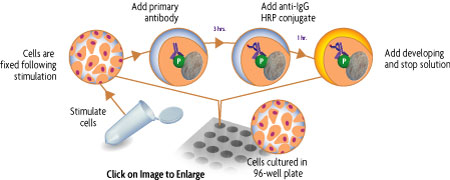THIS PRODUCT IS DISCONTINUED
Fast Activated Cell-based ELISA (FACE™) Kits provide a simple, sensitive method for detecting protein phosphorylation directly in the cell, without making extracts or performing electrophoresis and membrane blotting. These 96-well, high-throughput assays are available in both colorimetric and chemiluminescent formats for over 20 different targets (see list at right). For complete details, click the FACE™ Method tab below.
FACE HSP27 Kits provide 96 rxns each of 2 antibodies that enable you to monitor and compare the levels of both phosphorylated and total HSP27 (Heat Shock Protein 27). The phospho-HSP27 antibody recognizes HSP27 only when phosphorylated at Ser82. The total-HSP27 antibody recognizes HSP27 regardless of its phosphorylation state. Click the HSP27 Info tab below for data and more information.
| Name | Format | Cat No. | Price | |
|---|---|---|---|---|
| FACE™ HSP27 | 1 x 96 rxns | 48350 | Discontinued | |
| 5 x 96 rxns | 48850 | Discontinued | ||
| FACE™ HSP27 Chemi | 1 x 96 rxns | 48450 | Discontinued | |
| 5 x 96 rxns | 48950 | Discontinued | ||
| FACE™ HSP27 Manual |
| FACE™ Profile |
| Cell Biology Products Brochure |
| IsoCyte™ Application Note – Phospho-Protein Detection |
| MSDS: Sodium Azide |
| MSDS: Sulphuric Acid |
| MSDS: Thimersol |

Figure 1: Measurement of phosphorylated HSP27 (S82) and total HSP27.
Human HeLa cells were cultured in 96-well plates and serum-starved (0.5% FBS) for 16 hours. Cells were then stimulated with 25 µg/ml of Anisomycin for 30 minutes and fixed. Total HSP27 and HSP27 phosphorylated on Ser82 were each assayed in duplicate using the phospho-HSP27 (S82) and total-HSP27 antibodies included in the FACE HSP27 Kit. Data were plotted after correction for cell number (performed through use of Crystal Violet).
Antibody Specificities
The phospho-HSP27 (Ser82) antibody was raised against a synthetic phospho-peptide corresponding to residues surrounding phosphorylated Ser 82 of human HSP27. The phospho-HSP27 (Ser82) antibody recognizes HSP27 only when phosphorylated at Ser82. The total-HSP27 antibody recognizes HSP27 protein regardless of its phosphorylation state.
HSP27 Overview
In response to stress, the expression level of HSP27 increases several fold to confer cellular resistance to the adverse environmental change. HSP27 is localized to the cytoplasm of unstressed cells but can redistribute to the nucleus in response to stress, where it may function to stabilize DNA and/or the nuclear membrane. HSP27 is phosphorylated at serines 15, 78 and 82 by MAPKAPK-2 as a result of the activation of the p38 MAPK pathway. Phosphorylation of HSP27 causes a change in its tertiary structure, which shifts from large homotypic multimers to dimers and monomers. Thus, phosphorylated HSPs have significantly decreased ability to act as molecular chaperones. Phosphorylation of HSP27 on Ser82 by MAPKAPK-2 or AKT leads to HSP dissociation from the AKT/MAPKAPK2/p38 complex, which may promote independent survival signals. The phosphorylation of HSP27 also enhances its association with IKKβ which results in decreased IKK activity.
FACE™ の使用法
96ウェルプレートで細胞を培養し, 目的の経路を誘導する刺激を与えます。刺激を与えた後, 細胞を固定することでリン酸化を含むタンパク質修飾が保持されます。ブロッキング反応の後, それぞれのウェルに目的タンパク質に特異的な一次抗体, 続いてHRP標識二次抗体を加えます。その後, 発色試薬を加えることにより, 比色定量または化学発光による定量を簡便に行うことができます (図1)。また, キット付属のCrystal Violetを用いて細胞数を補正することができます。それぞれのFACE Kitには目的タンパク質全体とリン酸化型を認識する一次抗体が含まれます。これにより, 細胞数と細胞中の目的タンパク質の総量に対してのリン酸化型タンパク質量を解析することができます。FACEはリン酸化型タンパク質を解析することのできるキットで, 定量的かつ再現性のある結果が得られます。
図1: FACE の操作法
Contents & Storage
Two (or ten) 96-well plates for culturing cells, 96 (or 5 x 96) rxns each of two primary antibodies (1 phospho-specific, 1 specific for native protein), HRP-conjugated secondary antibody, Quenching Solution, 1X Antibody Blocking Buffer, 1X Antibody Dilution Buffer, 10X PBS, 10% Triton X-100, 1% SDS Solution, Developing and Stop Solutions, and Crystal Violet Cell Quantification Solution. Storage conditions vary from room temperature to -20°C, see manual for details. All reagents are guaranteed stable for 6 months when stored properly.


